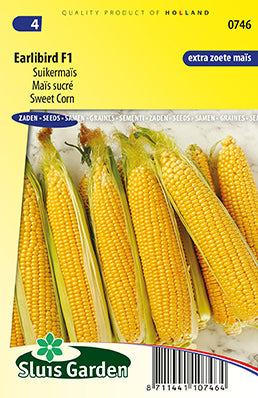Sweet Corn Earlibird F1
Sweet Corn Earlibird F1
Couldn't load pickup availability
Sweet Corn Earlibird F1
Growing Sweet Corn “Earlibird” can be a rewarding experience. Here’s a guide to help you cultivate Sweet Corn “Earlibird” successfully:
1. Planting Time: Plant Sweet Corn “Earlibird” seeds directly in the garden after the last frost date in your area. Corn is a warm-season crop, and it thrives in temperatures between 60°F to 95°F (15°C to 35°C).
2. Site Selection: Choose a sunny location with well-draining soil. Corn requires full sun for optimal growth and productivity.
3. Soil Preparation: Work the soil to a depth of at least 8 inches and amend it with well-rotted compost or aged manure. Corn prefers a slightly acidic to neutral soil with a pH between 6.0 and 6.8.
4. Planting Seeds: Plant corn seeds in blocks rather than single rows to ensure good pollination. Sow seeds 1-2 inches deep and space them about 8-12 inches apart in rows. Leave 30-36 inches between rows.
5. Watering: Keep the soil consistently moist, especially during the period when the plants are forming ears. Corn requires regular watering, and it’s crucial during the tasseling and silking stage.
6. Fertilization: Fertilize the soil before planting with a balanced fertilizer, and side-dress with nitrogen when the plants are knee-high. Follow the recommended guidelines on the fertilizer packaging.
7. Mulching: Apply a layer of organic mulch around the corn plants to retain soil moisture, suppress weeds, and regulate soil temperature.
8. Hilling: When the corn plants are about 12 inches tall, hill soil around the base of the stalks to provide stability and support.
9. Companion Planting: Consider planting companion crops like beans or squash with corn. This traditional trio, known as the “Three Sisters,” provides mutual benefits.
10. Pest Control: Keep an eye out for common pests such as corn earworms or aphids. Natural predators like ladybugs can help control aphids. For earworms, you can use biological controls or insecticidal treatments.
11. Harvesting: Sweet Corn “Earlibird” is ready for harvest when the silks have turned brown, and the kernels exude a milky fluid when punctured. Harvest in the morning for the best flavor.
12. Storage: Consume sweet corn as soon as possible for the freshest taste. If you have excess, it can be stored in the refrigerator for a short period.
13. Successive Planting: Consider successive plantings every two weeks for a continuous harvest throughout the growing season.
Growing Sweet Corn “Earlibird” requires attention to soil preparation, watering, and pest control. Enjoy the sweet, fresh taste of homegrown corn in your summer meals!
Share

